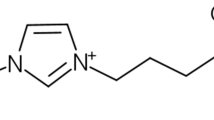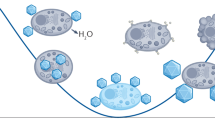Abstract
We report that the introduction of low concentrations of intracellular trehalose can greatly improve the survival of mammalian cells during cryopreservation. Using a genetically engineered mutant of Staphylococcus aureus α-hemolysin to create pores in the cellular membrane, we were able to load trehalose into cells. Low concentrations (0.2 M) of trehalose permitted long-term post-thaw survival of more than 80% of 3T3 fibroblasts and 70% of human keratinocytes. These results indicate that simplified and widely applicable freezing protocols may be possible using sugars as intracellular cryoprotective additives.
This is a preview of subscription content, access via your institution
Access options
Subscribe to this journal
Receive 12 print issues and online access
$209.00 per year
only $17.42 per issue
Buy this article
- Purchase on Springer Link
- Instant access to full article PDF
Prices may be subject to local taxes which are calculated during checkout




Similar content being viewed by others
References
Langer, R. & Vacanti, J.P. Tissue engineering: the development of functional substitutes for damaged tissue. Science 260, 920–926 (1993).
Mulligan, R.C. The basic science of gene therapy. Science 260, 926–932 (1993).
Mazur, P. Freezing of living cells: mechanisms and implications. Am. J. Physiol. 247, C125–C142 ( 1984).
Carpenter, J.F., Crowe, L.M. & Crowe, J.H. Stabilization of phosphofructokinase with sugars during freeze-drying. Biochim. Biophys. Acta 932, 109–115 (1987).
Crowe, L.M., Crowe, J.H., Rudolph, A., Wormersley, C. & Appel, L. Preservation of dried liposomes by trehalose. Arch. Biochem. Biophys. 242, 240–247 (1985).
Crowe, L.M., Mouradian, R., Crowe, J.H., Jackson, S.A. & Wormersly, C. Effect of carbohydrates on membrane stability at low water activities. Biochim. Biophys. Acta 769, 141–150 (1984).
Green, J.L. & Angell, C.A. Phase-relations and vitrification in saccharide–water solutions and the trehalose anomaly. J. Phys. Chem. 93, 2880–2882 (1989).
Bieganski, R.M., Fowler, A., Morgan & J.R. Toner, M. Stabilization of active recombinant retroviruses in an amorphos dry state with trehalose. Biotechnol. Prog. 14, 615–620 ( 1998).
Israeli, E., Shaffer, B.T. & Lighthart, B. Protection of freeze-dried Escherichia coli by trehalose upon exposure to environmental conditions. Cryobiology 30 519–523 ( 1993).
Rossi, S., Buera, M.P., Moreno, S. & Chirife, J. Stabilization of the restriction enzyme EcoRI dried with trehalose and other selected glass-forming solutions. Biotechnol. Prog. 13, 609–616 (1997).
Uritani, M., Takai, M. & Yoshinaga, K. Protective effect of disaccharides on restriction endonucleases during drying under vacuum. J. Biochem. 117, 774–779 (1995).
Miller, D.P., Pablo, J.J. & Corti, H. Thermophysical properties of trehalose and its concentrated aqueous solutions. Pharm. Res. 14, 578– 590 (1997).
Russo, M.J., Bayley, H. & Toner, M. Reversible permeabilization of plasma membranes with an engineered switchable pore. Nat. Biotechnol. 15, 278–282 (1997).
Walker, B., Kasianowicz, J., Krishnasastry, M. & Bayley, H. A pore-forming protein with a metal-actuated switch. Protein Eng. 7, 655–662 ( 1994).
Song, L. et al. Structure of staphylococcal α-hemolysin, a heptameric transmembrane pore. Science 274, 1859– 1866 (1996).
Bayley, H. Building doors into cells. Sci. Am. 277, 62–67 (1997).
Beattie, G.M. et al. Trehalose: a cryoprotectant that enhances recovery and preserves function of human pancreatic islets after long-term storage. Diabetes 46, 519–523 ( 1997).
Mazur, P., Farrant, J., Leibo, S.P. & Chu, E.H.Y. Survival of hamster tissue culture cells after freezing and thawing. Cryobiology 6, 1–9 (1969).
Mazur, P., Leibo, S.P. & Chu, E.H.Y. A two-factor hypothesis of freezing injury. Exp. Cell Res. 71, 345–355 (1972).
Walev, I. et al. Staphylococcal alpha-toxin kills human keratinocytes by permeabilizing the plasma membrane for monovalent ions. Infect. Immun. 61. 4972–4979 (1993).
Eming, S.A. & Morgan, J.R. in Methods in molecular medicine, gene therapy protocols. (ed. Robbins, P.) 265– 279 (Humana, Totowa, NJ; 1997).
Hildebrand, A., Pohl, M. & Bhakdi, S. Staphylococcus aureus α-toxin: dual mechanism of binding to target cells. J. Biol. Chem. 266, 17195–17200 (1991).
Walker, B., Braha, O., Cheley. S. & Bayley H. An intermediate in the assembly of a pore-forming protein trapped with a genetically engineered switch. Chem. Biol. 2, 99– 105 (1995).
Acknowledgements
This work was partially supported by the National Institutes of Health grants DK46270 and NS26760, Shriners Hospitals for Children, ONR and DOE. The authors thank Xiaofeng Lu for technical assistance. The authors also acknowledge Dr. Jeffrey Morgan's assistance in keratinocyte culture and evaluation. Michael J. Russo was a Howard Hughes Medical Institute Pre-Doctoral Fellow.
Author information
Authors and Affiliations
Corresponding author
Rights and permissions
About this article
Cite this article
Eroglu, A., Russo, M., Bieganski, R. et al. Intracellular trehalose improves the survival of cryopreserved mammalian cells. Nat Biotechnol 18, 163–167 (2000). https://doi.org/10.1038/72608
Received:
Accepted:
Issue Date:
DOI: https://doi.org/10.1038/72608
This article is cited by
-
Core–Shell Microfiber Encapsulation Enables Glycerol-Free Cryopreservation of RBCs with High Hematocrit
Nano-Micro Letters (2024)
-
Chemical approaches to cryopreservation
Nature Reviews Chemistry (2022)
-
A reversibly gated protein-transporting membrane channel made of DNA
Nature Communications (2022)
-
Accelerating cryoprotectant diffusion kinetics improves cryopreservation of pancreatic islets
Scientific Reports (2021)
-
Intracellular delivery of trehalose renders mesenchymal stromal cells viable and immunomodulatory competent after cryopreservation
Cytotechnology (2021)



